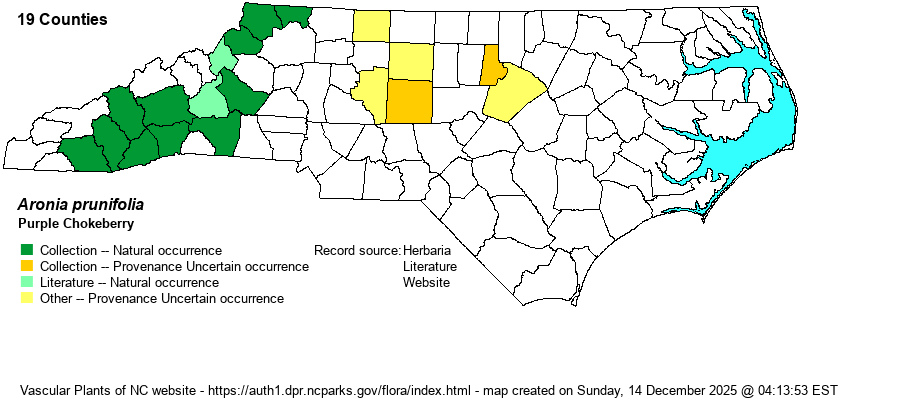| Section 6 » Family Rosaceae |
Show/Hide Synonym
| taxonName | relationship | relatedTaxonName | relatedTaxonRefText | relComments |
|---|
|
|
|
|
|
|
| Aronia prunifolia | = | Pyrus floribunda | Fernald (1950) | | | Aronia prunifolia | = | Pyrus floribunda | Flora of West Virginia | | | Aronia prunifolia | = | Pyrus floribunda | Kalkman in Kubitzki (2004). | | | Aronia prunifolia | = | Aronia ×floribunda | Flora of North America (1993b, 1997, 2000, 2002a, 2002b, 2003a, 2004b, 2005, 2006a, 2006b, 2006c, 2007a, 2009, 2010) | | | Aronia prunifolia | = | Photinia floribunda | | | | Aronia prunifolia | = | Photinia floribunda | Kalkman in Kubitzki (2004). | | | Aronia prunifolia | = | Sorbus arbutifolia var. atropurpurea | Radford, Ahles, and Bell (1968) | | | Aronia prunifolia | = | Aronia atropurpurea | Small (1933, 1938) | | | Aronia prunifolia | < | Aronia melanocarpa | Wofford (1989) | | | Source: Weakley's Flora |
|
| Author | (Marshall) Rehder | |
| Distribution | The distribution of this species is rather unsettled, owing to difficulty in identification. SERNEC specimens show its presence over nearly all of the Mountains, and rarely into the Piedmont foothills and elsewhere farther to the east. Weakley's (2018) map shows it as "uncommon" in both the Mountains and the Piedmont. The USDA map shows scattered records in the Piedmont, and the Digital Atlas of the Virginia Flora shows records to the southeastern corner of that state. Thus, it may well occur in NC over nearly all of the Piedmont; however, for now, records well into the Piedmont are being treated as Provenance Uncertain.
This taxon is a Northern species, ranging from Canada southward only to the mountains and Piedmont of NC and adjacent northwestern SC. It is perhaps unknown from TN and is very rare in KY.
| |
| Abundance | Uncommon or occasional in the Mountains, but it is suspected that it is mostly overlooked if not in fruit, as some references do not treat this as a valid or full species. Presumed to be very rare to rare in the Piedmont, and of uncertain provenance. Nonetheless, it is certainly rarer than the other two chokeberry species in the state. This is an NC Watch List species. | |
| Habitat | It is found in both upland and wetland habitats, in-between the preferences of A. arbutifolia (mainly in wetlands) and A. melanocarpa (mainly in uplands). It can be found on the margins of balds and exposed outcrops; however, most records come from non-riverine wetlands such as bogs, seepage areas, and swampy grounds. | |
| Phenology | Flowers in April and May; fruits in September and October. | |
| Identification | This is quite a poorly known taxon to most field workers, owing to its uncertain taxonomy and seeming scarcity in the state. It is a low deciduous shrub, generally only 3-5 feet tall, and can occur in colonies. The elliptical leaves are minutely serrated along the margins, as are the other two chokeberries. It is best identified primarily by its fruit color – dark reddish purple to blackish purple. The undersides of the leaves are sparsely pubescent; those of Red Chokeberry are densely pubescent, whereas Black Chokeberry leaves are essentially glabrous below. In all likelihood, you may need to see the plants with ripe fruit to be 100% sure of the identification. | |
| Taxonomic Comments | Though RAB (1968) considered this taxon as a variety of Aronia [Sorbus] arbutifolia – as Sorbus arbutifolia var. atropurpurea -- most references consider this as a hybrid of A. arbutifolia x melanocarpa. Weakley (2018) says: “While apparently originating as a hybrid between our other two species, A. prunifolia exists in populations independent of the two parent species, apparently reproducing successfully. It seems best to treat a now independent lineage such as this as a separate taxon.” It was also formerly named as Pyrus floribunda, Aronia atropurpurea, and a few others.
| |
| Other Common Name(s) | No others in frequent usage. | |
| State Rank | S2 | |
| Global Rank | GNA [G4G5] | |
| State Status | W1 | |
| US Status | | |
| USACE-agcp | FACW link |
| USACE-emp | FACW link |

